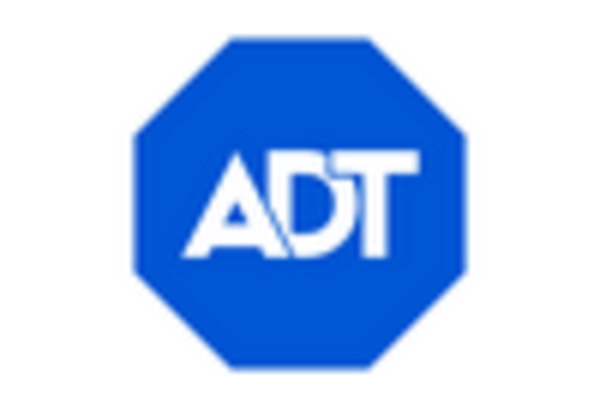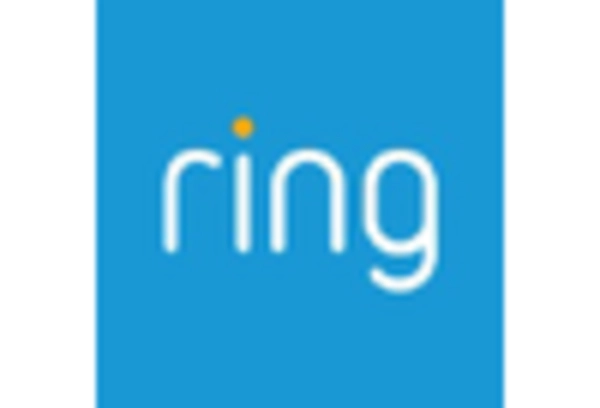Rising Security Concerns
The Smart Home Safety Market is experiencing a surge in demand driven by increasing security concerns among homeowners. As crime rates fluctuate, individuals are more inclined to invest in smart security systems that offer real-time monitoring and alerts. According to recent data, approximately 60 percent of homeowners express a desire for enhanced security measures, which has led to a notable increase in the adoption of smart locks, cameras, and alarm systems. This trend indicates a shift towards proactive safety measures, as consumers seek to protect their properties and loved ones. The integration of advanced technologies, such as facial recognition and motion detection, further enhances the appeal of these systems, making them a preferred choice for many. Consequently, the Smart Home Safety Market is poised for substantial growth as security becomes a paramount concern for consumers.
Technological Advancements
Technological advancements play a pivotal role in shaping the Smart Home Safety Market. Innovations in IoT, artificial intelligence, and machine learning have led to the development of sophisticated safety solutions that are not only effective but also user-friendly. For instance, smart cameras equipped with AI capabilities can distinguish between familiar faces and potential intruders, thereby reducing false alarms. The market has seen a significant increase in the deployment of smart home devices, with estimates suggesting that the number of connected devices could reach over 75 billion by 2025. This proliferation of technology enables seamless integration of various safety systems, allowing homeowners to monitor their properties from anywhere. As technology continues to evolve, the Smart Home Safety Market is likely to witness further enhancements, making safety solutions more accessible and efficient for consumers.
Regulatory Support and Standards
Regulatory support and the establishment of standards are crucial drivers for the Smart Home Safety Market. Governments and regulatory bodies are increasingly recognizing the importance of home safety and are implementing guidelines to ensure the reliability and security of smart home devices. This regulatory framework fosters consumer confidence, encouraging more individuals to invest in smart safety solutions. For example, initiatives aimed at promoting cybersecurity in smart devices are gaining traction, as they address concerns related to data privacy and security breaches. The presence of clear standards not only enhances product quality but also facilitates interoperability among devices, making it easier for consumers to adopt comprehensive safety systems. As regulatory support strengthens, the Smart Home Safety Market is likely to experience accelerated growth, as consumers feel more secure in their purchasing decisions.
Growing Awareness of Home Automation
The Smart Home Safety Market is benefiting from a growing awareness of home automation among consumers. As individuals become more familiar with the concept of smart homes, they are increasingly recognizing the advantages of integrating safety features into their living spaces. Reports indicate that nearly 70 percent of consumers are interested in automating their home security systems, which includes smart locks, surveillance cameras, and alarm systems. This trend is further fueled by the convenience and peace of mind that comes with remote monitoring capabilities. Home automation not only enhances security but also contributes to energy efficiency and overall home management. As awareness continues to spread, the Smart Home Safety Market is expected to expand, with more consumers seeking comprehensive solutions that combine safety and automation.
Increased Investment in Smart Home Technologies
Increased investment in smart home technologies is a significant driver for the Smart Home Safety Market. Venture capital and corporate investments in smart home startups have surged, reflecting a growing belief in the potential of these technologies. Recent estimates suggest that investments in smart home solutions could exceed 100 billion dollars by 2025, indicating a robust market outlook. This influx of capital is facilitating research and development, leading to the introduction of innovative safety products that cater to evolving consumer needs. Furthermore, established technology companies are expanding their portfolios to include smart safety solutions, thereby enhancing competition and driving down prices. As investment continues to flow into the sector, the Smart Home Safety Market is expected to thrive, offering consumers a wider array of choices and advanced safety features.

















Leave a Comment